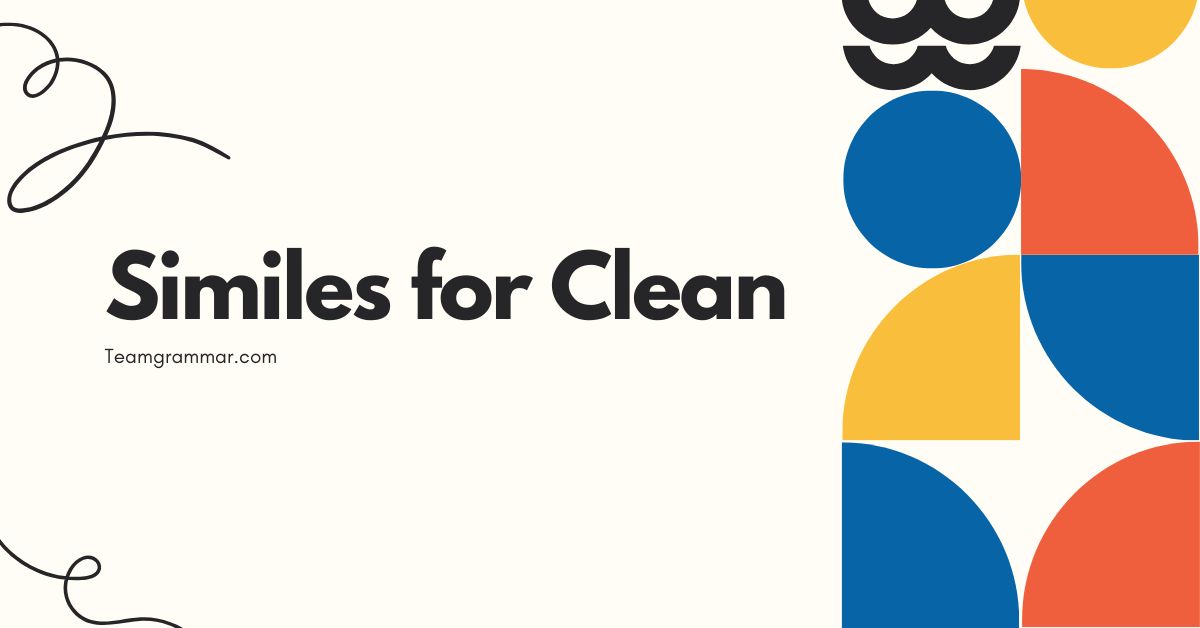41 Similes for Clean: Mastering Figurative Language
Understanding similes is crucial for enhancing both your writing and comprehension skills in English. Similes, a type of figurative language, allow you to create vivid and engaging descriptions by comparing one thing to another using “like” or “as.” This article provides a comprehensive guide to using similes effectively, focusing on descriptions related to cleanliness.
Whether you’re a student, writer, or language enthusiast, this resource will help you master the art of using similes to add depth and color to your language.
By exploring various examples and practical exercises, you will learn how to craft compelling comparisons that evoke specific images and emotions. This guide covers everything from basic definitions to advanced usage, ensuring a thorough understanding of similes and their application in different contexts.
Table of Contents
- Introduction
- Definition of Simile
- Structural Breakdown of Similes
- Types of Similes
- Examples of Similes for Clean
- Usage Rules for Similes
- Common Mistakes with Similes
- Practice Exercises
- Advanced Topics in Similes
- Frequently Asked Questions
- Conclusion
Introduction
Similes are powerful tools in the English language, enabling writers and speakers to create vivid, memorable images by comparing two unlike things. Understanding how to use similes effectively can significantly enhance your writing, making it more engaging and descriptive.
This article focuses specifically on similes related to the concept of “clean,” providing numerous examples and practical exercises to help you master this skill.
The ability to craft compelling similes is valuable for anyone looking to improve their communication, whether in creative writing, professional correspondence, or everyday conversation. By learning to use similes effectively, you can add depth, nuance, and creativity to your language.
Definition of Simile
A simile is a figure of speech that compares two different things using the words “like” or “as.” The purpose of a simile is to create a more vivid and descriptive image in the reader’s or listener’s mind. Similes help to draw connections between seemingly unrelated concepts, adding depth and color to language.
Similes are classified as a type of figurative language, which means they are not meant to be taken literally. Instead, they rely on imaginative comparisons to convey a particular meaning or feeling.
The effectiveness of a simile depends on the clarity and relevance of the comparison.
Function of Similes
The primary function of a simile is to enhance description by creating a mental image. By comparing something to something else familiar, similes help the audience understand and visualize the subject more clearly.
They also add emphasis and emotional impact to writing.
Similes can also be used to simplify complex ideas by relating them to more understandable concepts. This makes them a valuable tool in both creative and informative writing.
Contexts for Using Similes
Similes are appropriate in a wide range of contexts, from creative writing and poetry to everyday conversation and professional communication. They are particularly useful in situations where you want to add color, emphasis, or clarity to your language.
In creative writing, similes can help to create vivid imagery and evoke specific emotions. In professional settings, they can be used to simplify complex ideas or make presentations more engaging.
Even in casual conversation, similes can add humor and personality to your speech.
Structural Breakdown of Similes
A simile typically consists of two main components: the subject being described and the object to which it is being compared. These two components are connected by the words “like” or “as.” Understanding the structural elements of a simile is essential for creating effective and meaningful comparisons.
The general structure of a simile can be represented as follows: Subject + “like” or “as” + Object.
Subject
The subject is the thing being described in the simile. It is the focus of the comparison and the element that you want to make more vivid or understandable.
The subject can be a noun, pronoun, or phrase.
For example, in the simile “The kitchen was as clean as a whistle,” the subject is “The kitchen.”
Comparison Words: “Like” and “As”
The words “like” and “as” are the key indicators that a statement is a simile. They connect the subject to the object of comparison, indicating that the two are similar in some way.
While “like” and “as” are the most common comparison words, it’s important to use them correctly to ensure the simile is clear and effective. “Like” is used to compare nouns and pronouns, while “as” can be used in a variety of constructions.
Object of Comparison
The object of comparison is the thing to which the subject is being compared. It should be something familiar or easily understood so that the comparison adds clarity and depth to the description.
The object can also be a noun, pronoun, or phrase.
In the simile “The kitchen was as clean as a whistle,” the object of comparison is “a whistle.” The cleanliness of a whistle is used to emphasize how clean the kitchen is.
Types of Similes
While all similes serve the same basic function of comparing two things using “like” or “as,” they can be categorized based on the type of comparison they make. Understanding these different types can help you craft more effective and nuanced similes.
Similes can be broadly categorized into descriptive similes, emphatic similes, and ironic similes.
Descriptive Similes
Descriptive similes are used to provide a vivid and detailed description of the subject. They focus on highlighting specific qualities or characteristics by comparing them to something else.
For example, “The countertop was as clean as a mirror” is a descriptive simile that emphasizes the shininess and lack of smudges on the countertop.
Emphatic Similes
Emphatic similes are used to add emphasis or intensity to a statement. They make a strong comparison to highlight the importance or significance of the subject.
For example, “The house was as clean as a hospital operating room” is an emphatic simile that underscores the extreme level of cleanliness in the house.
Ironic Similes
Ironic similes are used to create a humorous or sarcastic effect by making a comparison that is intentionally contradictory or unexpected. These types of similes often rely on irony to convey their meaning.
For example, “His attempt to clean the bathroom was about as effective as rearranging deck chairs on the Titanic” is an ironic simile that suggests the cleaning effort was futile.
Examples of Similes for Clean
Here are several examples of similes that can be used to describe cleanliness. These examples are organized into categories to help you understand the different ways similes can be used to convey the concept of “clean.”
The following tables provide a wide range of examples, each designed to illustrate different aspects of cleanliness and how they can be effectively communicated through similes.
General Cleanliness
This table presents similes that describe cleanliness in a general sense, applicable to various objects and spaces.
| Simile | Explanation |
|---|---|
| As clean as a whistle | Indicates a high degree of cleanliness. |
| As clean as a new pin | Suggests something is spotless and unused. |
| As clean as a hound’s tooth | Emphasizes thorough cleanliness, implying even the smallest details are attended to. |
| As clean as a freshly laundered sheet | Evokes the image of crisp, clean fabric. |
| As clean as a polished mirror | Highlights the absence of smudges or dirt. |
| As clean as a surgeon’s hands | Implies a level of cleanliness necessary for sterile environments. |
| As clean as a brand new car | Suggests the pristine condition of a new vehicle. |
| As clean as a blank canvas | Implies a fresh start, free from any marks or blemishes. |
| As clean as a clear mountain stream | Evokes the purity and clarity of natural water sources. |
| As clean as a just-washed window | Highlights the transparency and lack of streaks. |
| As clean as a whistle | Indicates a high degree of cleanliness. |
| As clean as a new pin | Suggests something is spotless and unused. |
| As clean as a hound’s tooth | Emphasizes thorough cleanliness. |
| As clean as a freshly laundered sheet | Evokes the image of crisp, clean fabric. |
| As clean as a polished mirror | Highlights the absence of smudges. |
| As clean as a surgeon’s hands | Implies sterile conditions. |
| As clean as a brand new car | Suggests the pristine condition. |
| As clean as a blank canvas | Implies a fresh start. |
| As clean as a clear mountain stream | Evokes purity. |
| As clean as a just-washed window | Highlights transparency. |
Household Cleanliness
This table focuses on similes that relate to the cleanliness of various household items and spaces.
| Simile | Explanation |
|---|---|
| As clean as a kitchen sink after scrubbing | Emphasizes the thorough cleaning of a frequently used area. |
| As clean as a freshly vacuumed carpet | Suggests the removal of all visible dirt and debris. |
| As clean as a bathroom after a deep clean | Implies a comprehensive cleaning process that leaves no area untouched. |
| As clean as a dust-free shelf | Highlights the absence of dust and particles. |
| As clean as a sanitized countertop | Emphasizes the removal of germs and bacteria. |
| As clean as a well-maintained garden | Suggests orderliness and the absence of weeds or debris. |
| As clean as a sparkling chandelier | Highlights the brilliance and clarity achieved through cleaning. |
| As clean as a polished hardwood floor | Emphasizes the shine and smoothness of the floor. |
| As clean as an organized closet | Suggests neatness and the absence of clutter. |
| As clean as a neatly made bed | Highlights the orderliness and tidiness of the bedding. |
| As clean as a kitchen sink after scrubbing | Emphasizes the thorough cleaning. |
| As clean as a freshly vacuumed carpet | Suggests the removal of dirt. |
| As clean as a bathroom after a deep clean | Implies a comprehensive process. |
| As clean as a dust-free shelf | Highlights the absence of dust. |
| As clean as a sanitized countertop | Emphasizes the removal of germs. |
| As clean as a well-maintained garden | Suggests orderliness. |
| As clean as a sparkling chandelier | Highlights the brilliance. |
| As clean as a polished hardwood floor | Emphasizes the shine. |
| As clean as an organized closet | Suggests neatness. |
| As clean as a neatly made bed | Highlights tidiness. |
Personal Cleanliness
This table provides similes that describe personal hygiene and cleanliness.
| Simile | Explanation |
|---|---|
| As clean as someone who just stepped out of the shower | Emphasizes freshness and the absence of body odor. |
| As clean as a baby’s skin | Suggests purity and softness. |
| As clean as a freshly brushed set of teeth | Highlights the removal of plaque and food particles. |
| As clean as freshly washed hair | Emphasizes the absence of oil and dirt in the hair. |
| As clean as a well-groomed pet | Suggests attention to hygiene and the absence of tangles or mats in the fur. |
| As clean as a newly laundered shirt | Highlights the crispness and cleanliness of the fabric. |
| As clean as a manicure | Suggests neatness and attention to detail in personal grooming. |
| As clean as a whistle after mouthwash | Emphasizes freshness and the absence of bad breath. |
| As clean as a sanitized wound | Suggests the removal of bacteria and the prevention of infection. |
| As clean as a person who washes their hands frequently | Highlights the importance of hygiene practices. |
| As clean as someone who just stepped out of the shower | Emphasizes freshness. |
| As clean as a baby’s skin | Suggests purity. |
| As clean as a freshly brushed set of teeth | Highlights the removal of plaque. |
| As clean as freshly washed hair | Emphasizes the absence of oil. |
| As clean as a well-groomed pet | Suggests attention to hygiene. |
| As clean as a newly laundered shirt | Highlights crispness. |
| As clean as a manicure | Suggests neatness. |
| As clean as a whistle after mouthwash | Emphasizes freshness. |
| As clean as a sanitized wound | Suggests the removal of bacteria. |
| As clean as a person who washes their hands frequently | Highlights hygiene practices. |
Metaphorical Cleanliness
This table showcases similes that use “clean” in a more abstract or metaphorical sense, often referring to purity or moral integrity.
| Simile | Explanation |
|---|---|
| As clean as a conscience | Suggests a clear and guilt-free state of mind. |
| As clean as a record | Highlights the absence of any negative information or history. |
| As clean as a fresh start | Implies the opportunity to begin anew without past mistakes or burdens. |
| As clean as a politician’s promise before an election | (Often used ironically) Suggests a deceptive appearance of purity. |
| As clean as pure intent | Emphasizes the absence of ulterior motives or hidden agendas. |
| As clean as unsullied reputation | Highlights the absence of scandal or negative publicity. |
| As clean as truth | Suggests honesty and transparency. |
| As clean as a clear understanding | Implies the absence of confusion or ambiguity. |
| As clean as a well-written contract | Suggests clarity and the absence of loopholes or hidden clauses. |
| As clean as a pristine snowfield | Evokes the image of untouched purity. |
| As clean as a conscience | Suggests a guilt-free state. |
| As clean as a record | Highlights the absence of negative history. |
| As clean as a fresh start | Implies a new beginning. |
| As clean as a politician’s promise before an election | (Often ironic) Suggests deception. |
| As clean as pure intent | Emphasizes the absence of ulterior motives. |
| As clean as unsullied reputation | Highlights the absence of scandal. |
| As clean as truth | Suggests honesty. |
| As clean as a clear understanding | Implies the absence of confusion. |
| As clean as a well-written contract | Suggests clarity. |
| As clean as a pristine snowfield | Evokes purity. |
Usage Rules for Similes
While similes are relatively straightforward to use, there are some key rules to keep in mind to ensure your comparisons are effective and appropriate. These rules relate to clarity, relevance, and avoiding clichés.
Following these usage rules will help you to craft similes that enhance your writing and communication, making them more vivid, engaging, and impactful.
Clarity
A good simile should be clear and easy to understand. The comparison should be immediately apparent, and the object of comparison should be something familiar to the audience.
Avoid using obscure or overly complex comparisons that may confuse the reader or listener.
For example, instead of saying “The floor was as clean as a quantum field,” which may be confusing to many, say “The floor was as clean as a polished mirror.”
Relevance
The comparison made in a simile should be relevant to the subject being described. The object of comparison should share a significant quality or characteristic with the subject.
Avoid making comparisons that are illogical or nonsensical.
For example, if you are describing the cleanliness of a kitchen, comparing it to something unrelated, like “as clean as outer space,” would not be effective.
Originality
While some common similes are well-known and widely used, it is often more effective to create original comparisons that are fresh and engaging. Avoid relying too heavily on clichés, as they can make your writing seem uninspired.
Instead of saying “as clean as a whistle,” try to come up with a more unique simile that captures the specific aspect of cleanliness you want to emphasize. For example, “The countertop was as clean as the surface of a new smartphone.”
Contextual Appropriateness
Consider the context in which you are using the simile. The tone and style of your writing or speech should influence the type of simile you choose.
A simile that is appropriate in a casual conversation may not be suitable for a formal presentation.
In a formal setting, it is best to use similes that are clear, direct, and professional. In a more casual setting, you can experiment with more creative and humorous comparisons.
Common Mistakes with Similes
Even experienced writers and speakers can make mistakes when using similes. Being aware of these common errors can help you to avoid them and ensure that your similes are effective and appropriate.
Correcting these common mistakes will significantly improve the clarity and impact of your similes.
Confusing Similes with Metaphors
One common mistake is confusing similes with metaphors. While both are figures of speech that make comparisons, similes use “like” or “as,” while metaphors state that one thing *is* another.
Incorrect: The kitchen was a whistle. (This is a metaphor, but not a well-formed one)
Correct: The kitchen was as clean as a whistle. (This is a simile)
Overusing Cliches
Relying too heavily on clichéd similes can make your writing seem uninspired and predictable. While some common similes are widely understood, it is often more effective to create original comparisons.
Cliché: As clean as a whistle.
Better: As clean as a laboratory slide.
Illogical Comparisons
A simile should make a logical and relevant comparison. Avoid comparing things that have little or nothing in common, as this can confuse the reader or listener.
Incorrect: The countertop was as clean as a bicycle.
Correct: The countertop was as clean as a new mirror.
Overly Complex Comparisons
A simile should be clear and easy to understand. Avoid using overly complex or obscure comparisons that may confuse the audience.
Incorrect: The room was as clean as a fractal dimension.
Correct: The room was as clean as a showroom.
Practice Exercises
Test your understanding of similes with these practice exercises. Complete the following sentences with appropriate similes.
These exercises are designed to help you apply your knowledge of similes and improve your ability to create effective comparisons.
Fill-in-the-Blank Exercises
Complete the following sentences with appropriate similes related to cleanliness.
| Question | Answer |
|---|---|
| 1. The bathroom was ______________ after the cleaning lady finished. | 1. The bathroom was as clean as a hotel suite after the cleaning lady finished. |
| 2. His teeth were ______________ after brushing. | 2. His teeth were as clean as a pearl necklace after brushing. |
| 3. The car’s interior was ______________ after the detailing service. | 3. The car’s interior was as clean as a showroom model after the detailing service. |
| 4. The kitchen floor was ______________ after mopping. | 4. The kitchen floor was as clean as a skating rink after mopping. |
| 5. Her conscience was ______________ after she apologized. | 5. Her conscience was as clean as a blank slate after she apologized. |
| 6. The air in the mountains was ______________. | 6. The air in the mountains was as clean as a fresh spring breeze. |
| 7. The baby’s skin felt ______________. | 7. The baby’s skin felt as clean as a petal of a flower. |
| 8. The operating room had to be ______________. | 8. The operating room had to be as clean as a sterile laboratory. |
| 9. The new policy was designed to be ______________. | 9. The new policy was designed to be as clean as a transparent glass. |
| 10. The report was ______________, with no errors. | 10. The report was as clean as a proofread manuscript, with no errors. |
Identify the Simile Exercises
Identify the similes in the following sentences.
| Question | Answer |
|---|---|
| 1. The house was as clean as a pin, ready for the guests to arrive. | 1. as clean as a pin |
| 2. After the rain, the air felt as clean as a mountain stream. | 2. as clean as a mountain stream |
| 3. Her record at the company was clean, like a polished trophy. | 3. clean, like a polished trophy |
| 4. The newly renovated kitchen was as clean as a professional chef’s workspace. | 4. as clean as a professional chef’s workspace |
| 5. The data was presented as clean as a well-organized spreadsheet. | 5. as clean as a well-organized spreadsheet |
| 6. His intentions were as clean as fresh snow. | 6. as clean as fresh snow |
| 7. The cleaned windows were as clean as air. | 7. as clean as air |
| 8. The patient’s wound was as clean as a sterilized instrument. | 8. as clean as a sterilized instrument |
| 9. The agreement was written to be as clean as simple mathematics. | 9. as clean as simple mathematics |
| 10. The project’s code was as clean as a programmer’s dream. | 10. as clean as a programmer’s dream |
Create Your Own Simile Exercises
Create your own similes for the following scenarios related to cleanliness.
| Scenario | Possible Simile |
|---|---|
| 1. Describe a freshly cleaned car. | 1. The freshly cleaned car looked as clean as a mirror reflecting the sun. |
| 2. Describe a clean hospital room. | 2. The clean hospital room was as clean as a laboratory, ready for experiments. |
| 3. Describe a clean kitchen countertop. | 3. The clean kitchen countertop felt as clean as a smooth, unblemished stone. |
| 4. Describe a person with a clean reputation. | 4. A person with a clean reputation is as clean as a clear, cloudless sky. |
| 5. Describe the feeling of clean laundry. | 5. The feeling of clean laundry is as clean as a fresh start to the day. |
| 6. Describe a clean beach. | 6. The clean beach was as clean as a painting, untouched by footprints. |
| 7. Describe a clean conscience after admitting a mistake. | 7. A clean conscience after admitting a mistake is as clean as rain washing away the dust. |
| 8. Describe a clean workspace. | 8. A clean workspace is as clean as a blank canvas, ready for creativity. |
| 9. Describe a clean glass window. | 9. A clean glass window is as clean as not even being there. |
| 10. Describe a clean bill of health. | 10. A clean bill of health is as clean as a brand new certificate. |
Advanced Topics in Similes
For advanced learners, there are several more complex aspects of similes to explore. These include extended similes, implied similes, and the use of similes in literary analysis.
Delving into these advanced topics will further refine your understanding and application of similes in diverse contexts.
Extended Similes
An extended simile is a simile that is developed over several lines or sentences. Instead of making a brief comparison, an extended simile explores the similarities between the subject and object in greater detail, creating a more elaborate and impactful image.
For example: “The room was as clean as a laboratory, every surface gleaming under the fluorescent lights, the air free of any dust or particles, the equipment arranged with meticulous precision, ready for scientific inquiry.”
Implied Similes
An implied simile is a simile that does not explicitly use the words “like” or “as.” Instead, the comparison is suggested indirectly through descriptive language and imagery.
For example, instead of saying “The floor gleamed like a mirror,” you might say “The floor gleamed, a mirror reflecting the overhead lights,” implying the comparison without using “like” or “as.”
Similes in Literary Analysis
Similes are frequently used in literature to enhance description, create imagery, and convey deeper meanings. Analyzing the similes in a literary work can provide valuable insights into the author’s style, themes, and intentions.
When analyzing similes, consider the qualities being compared, the effect of the comparison on the reader, and the overall contribution of the simile to the meaning and impact of the text.
Frequently Asked Questions
Here are some frequently asked questions about similes, along with detailed answers to help clarify any confusion.
- What is the difference between a simile and a metaphor?
A simile compares two things using “like” or “as,” while a metaphor states that one thing *is* another. Similes are explicit comparisons, while metaphors are implicit.
- Can a simile be a cliché?
Yes, if a simile is overused and lacks originality, it becomes a cliché. It’s best to create fresh and unique comparisons.
- How can I make my similes more effective?
Focus on clarity, relevance, and originality. Choose comparisons that are easy to understand and that highlight meaningful similarities between the subject and object.
- Is it okay to use similes in formal writing?
Yes, but use them judiciously. Ensure they are clear, appropriate for the tone, and enhance rather than detract from the message.
- What if my simile doesn’t make sense to everyone?
Aim for comparisons that are widely understood. If necessary, provide context or explanation to ensure clarity.
- How many similes should I use in a piece of writing?
Use similes sparingly and strategically. Overusing them can make your writing seem excessive and unnatural.
- Can I use similes in spoken language?
Absolutely! Similes can add color and emphasis to your speech, making it more engaging and memorable.
- What role does a simile play in poetry?
Similes are essential in poetry for creating imagery, conveying emotions, and adding depth to the poet’s message.
- How do I avoid using clichés when creating similes?
Think outside the box and try to find unique and unexpected comparisons. Consider the specific qualities you want to highlight and brainstorm objects or concepts that share those qualities in a fresh way.
- Can a simile be used ironically?
Yes, ironic similes can be used to create humor or sarcasm by making a comparison that is intentionally contradictory or unexpected.
- How do I choose the right object of comparison for my simile?
Consider the qualities you want to emphasize and choose an object that vividly embodies those qualities. The object should be something familiar to your audience to ensure the comparison is clear and effective.
Conclusion
Mastering the use of similes can significantly enhance your writing and communication skills. By understanding the structure, types, and usage rules of similes, you can craft compelling comparisons that add depth, color, and clarity to your language.
Remember to focus on clarity, relevance, and originality to create effective and engaging similes.
Practice is key to improving your ability to use similes effectively. Experiment with different comparisons, analyze the similes used by other writers, and seek feedback on your own writing.
With consistent effort, you can become proficient in the art of using similes to enhance your communication.







